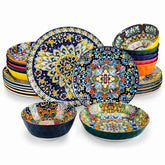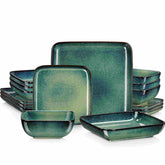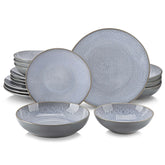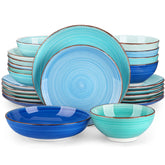Japanese Tableware: The Art of Elegance and Tradition
Japanese cuisine is renowned for its delicate flavors, meticulous presentation, and rich cultural heritage. Central to the Japanese dining experience is the exquisite tableware that enhances the beauty and authenticity of the food. In this blog post, we will delve into the world of Japanese tableware, exploring its unique features, traditional craftsmanship, and the profound influence it has on the dining experience.
I. Aesthetic Principles of Japanese Tableware
Japanese tableware embodies the principles of simplicity, harmony, and respect for nature. The design philosophy is deeply rooted in the concept of "wabi-sabi," which embraces imperfection and celebrates the beauty of the natural world. The clean lines, minimalist forms, and earthy colors of Japanese tableware reflect these principles, creating a serene and harmonious dining atmosphere.
II. Traditional Materials and Techniques
Japanese tableware showcases a wide range of traditional materials and craftsmanship techniques, each contributing to the overall charm and authenticity. Some notable examples include:
Porcelain (Hakuji): Known for its fine texture and translucent appearance, porcelain tableware is highly valued for its elegance and delicacy.
Stoneware (Tsuchi-korai): Characterized by its earthy tones and rustic textures, stoneware embodies a sense of warmth and authenticity, often used for traditional Japanese dishes.
Lacquerware (Shikki): Crafted from layers of lacquer, these tableware pieces display a glossy finish and exquisite hand-painted designs. Lacquerware is not only visually appealing but also durable and resistant to heat and moisture.
Bamboo (Take): Bamboo tableware showcases the versatility of this sustainable material, often used for sushi mats, chopsticks, and tea utensils. Its natural texture and lightweight properties add a touch of organic beauty to the table.
III. Forms and Functionality
Japanese tableware encompasses a wide variety of forms, each designed with a specific function in mind. Some notable examples include:
Bowls (soup bowl): Used for rice, miso soup, and noodle dishes, Japanese bowls are characterized by their shallow shape and wide rim, allowing for easy consumption and appreciation of the food's colors and textures.
Plates (Sara): Plates in Japanese tableware come in various sizes and shapes, serving as a canvas for presenting appetizers, main courses, and desserts. The simplicity of design allows the food to take center stage.
Tea Ware (Chawan, Chasen, Chashaku): Tea ceremonies hold a special place in Japanese culture, and the tea ware used reflects the artistry and precision involved in the ritual. The tea bowl (chawan), tea whisk (chasen), and tea scoop (chashaku) are meticulously crafted and contribute to the serene ambiance of the ceremony.
IV. Cultural Significance
Japanese tableware not only serves a functional purpose but also holds deep cultural significance. The careful selection and arrangement of tableware items convey respect and attention to detail. The act of using chopsticks, pouring tea, and savoring each bite becomes a meditative practice, fostering a connection between the diner, the food, and the surrounding environment.
V. Contemporary Adaptations
While Japanese tableware embraces tradition, contemporary adaptations also offer innovative designs that blend modern aesthetics with traditional craftsmanship. These adaptations cater to evolving lifestyles and preferences, allowing for a fusion of functionality, style, and cultural heritage. Modern Japanese tableware may feature bold colors, geometric patterns, or experimental forms while still maintaining a sense of elegance and respect for the dining experience.
VI. The Ritual of Japanese Tableware
Japanese tableware is not simply an arrangement of plates and bowls; it is a reflection of a deep-rooted cultural ritual. From the precise placement of each dish to the meticulous pouring of tea, every aspect of the dining experience is considered. This attention to detail creates a sense of mindfulness and appreciation for the present moment, making each meal a sensory journey.
VII. Bringing Japanese Tableware into Your Home
Bringing the elegance of Japanese tableware into your own home can enhance your dining experiences and introduce a touch of Japanese culture. Consider incorporating traditional Japanese tableware items such as tea sets, sushi plates, or sake cups into your collection. Whether used for special occasions or daily meals, these pieces can infuse your dining rituals with a sense of tranquility and beauty.
VIII. Caring for Japanese Tableware
To preserve the beauty and longevity of Japanese tableware, proper care is essential. Many traditional materials require specific handling and cleaning methods. For example, lacquerware should be gently wiped clean with a soft cloth, avoiding abrasive cleaning agents. Porcelain and stoneware can typically be washed with mild detergent and warm water. It's important to follow the manufacturer's recommendations for each specific type of tableware.
Conclusion
Japanese tableware embodies the essence of Japanese culture and its unique approach to aesthetics, craftsmanship, and ritual. From the selection of materials to the intricate designs, each element is carefully considered to create a harmonious dining experience. By incorporating Japanese tableware into our own homes and practices, we can cultivate a deeper appreciation for the artistry, tradition, and mindfulness that accompany each meal. Let the elegance and simplicity of Japanese tableware inspire you to create memorable dining moments and explore the rich cultural heritage of Japan.











